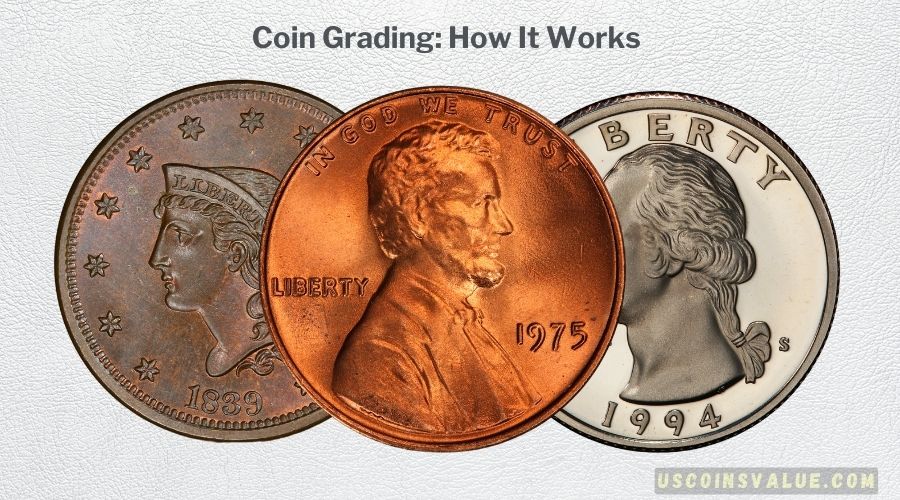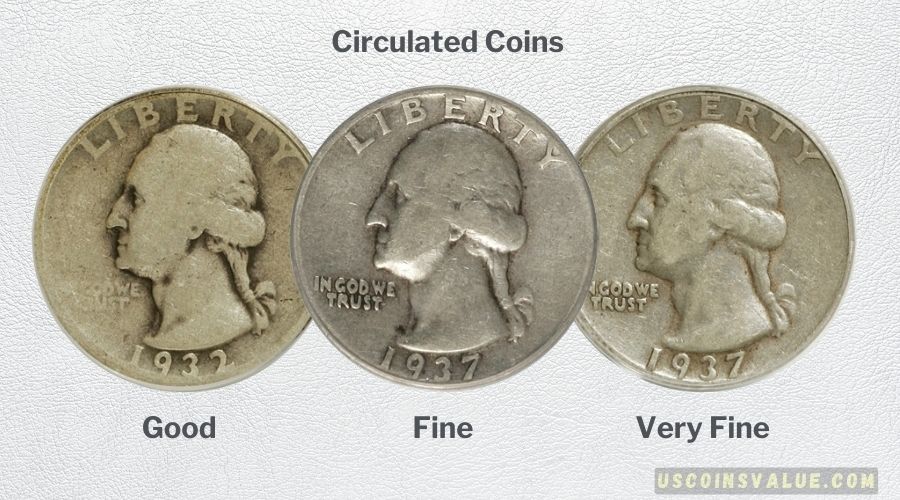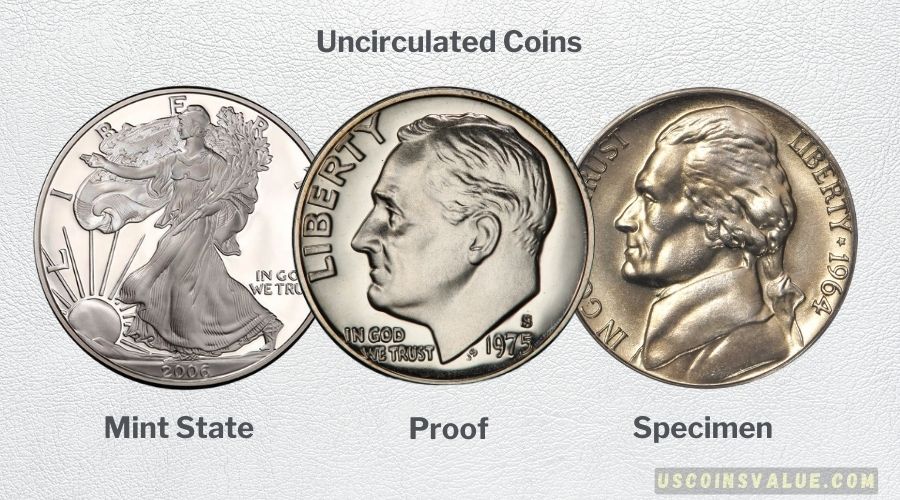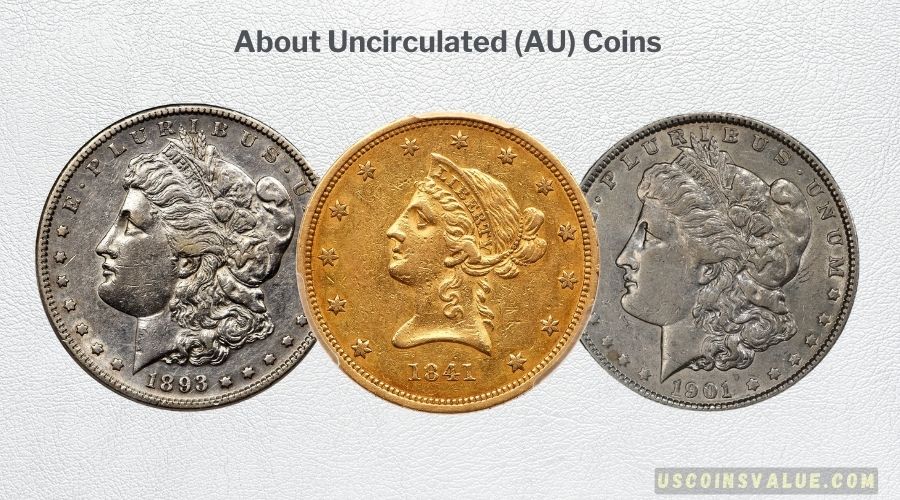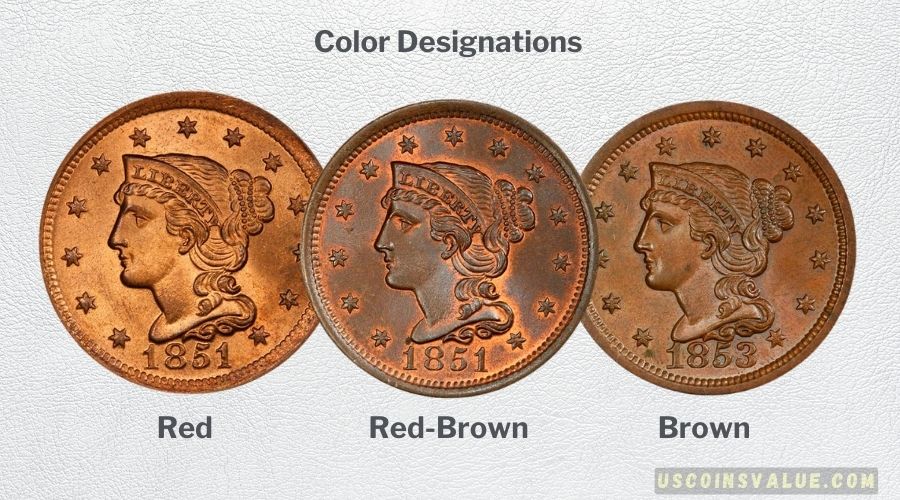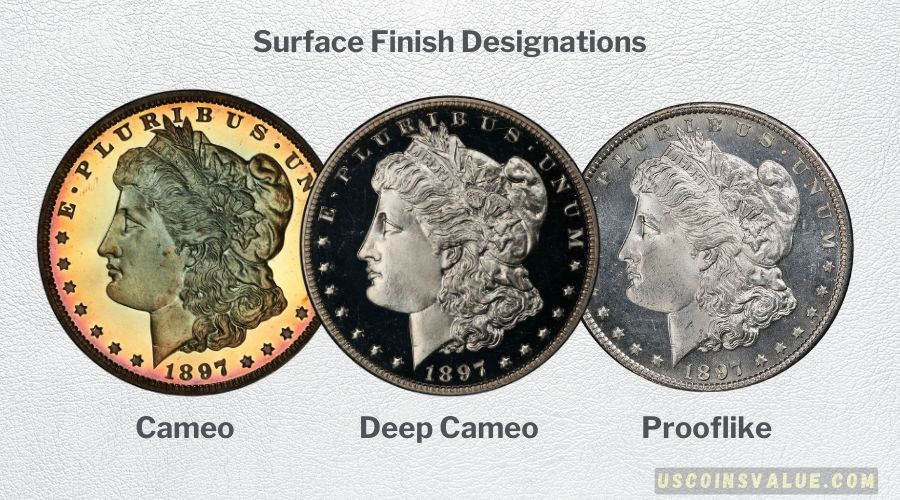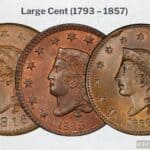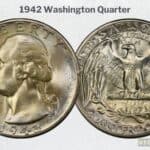Coin grades are labels assigned to coins, indicating their physical state and condition. The purpose of a coin grading scale is to provide a standardized evaluation of coin conditions, which in turn helps determine their true market value.
An example of a coin grade is MS-70; MS means Mint State indicating this is an uncirculated business coin and 70 is the highest numerical grade given to the most pristine-looking coins. Do not worry if this is confusing, by the end of this post, it will be second nature to you.
United States Coins are graded based on the American Numismatic Association (ANA) Grading Standards. A few changes have been made to the scale over the years by different third parties but they all follow a 70-point coin grading scale known as the Sheldon Scale.
In this article, you will learn everything you need to know about the U.S. coin grading system and the best coin grading services for reputable certifications and authentication.
How the Coin Grading Scale Works
The modern grades are based on the Sheldon Scale developed by William Herbert Sheldon in 1948. Sheldon Scale ranges from 1 to 70 where 70 is the highest scale and 1 the least.
The grading scale is divided between 1 and 70 according to the coin’s physical conditions: attractiveness, level of imperfections, nature of strike, toning, luster, scratches, and color.
All these traits can be subjective and fluctuate based on the grader’s judgment. Some graders are more generous than others and this can lead to an inflation of coins which are valued higher than they should be.
To help minimize this uncertainty of quality, the American Numismatic Association came up with the ANA Grading Standards in 1978 which are used to date to grade United States coins. ANA Grading Standards are based on the Sheldon Scale but include some changes and additions.
The standards help in evaluating a coin’s true value, make it easier to identify counterfeit coins, and it much harder to be cheated out of your coin’s worth. Despite these benefits, it is important to note that coin grading is more of an art form than an exact science.
The ANA Grading Standards offer a general overview of coin traits. However, when it comes to the most minute details, different graders often grade the same coin differently.
The tinnier the imperfection the higher the chances of it receiving different grades from different graders. This is the biggest shortcoming of coin grading systems and that is why it is crucial to know how the system works to apply your own judgment when doubling in the collectors’ market.
The coin grading scale is applied across all three types of U.S. coins:
1. Circulated Coins
These are business coins used in commerce and everyday transactions. They are the most worn-out coins with the least graded conditions.
Circulated coins, primarily graded based on the extent of wear they have seen, are easier to grade than Mint State coins.
Words like Poor, Fair, Good, Fine, and Extremely Fine are used to describe the coins’ details. Poor are the least graded coins while Extremely Fine (EF) are circulation coins with the highest grade.
2. Uncirculated Coins
These are coins without any wear at all and with the same appearance they had when they left the mint. This is because they did not go into day-to-day business use but rather kept or sold to collectors in sealed mint condition capsules.
Every design detail is clear and any imperfections come from production processes rather than commercial use.
There are three categories:
- MS (Mint State) – Uncirculated versions of the regular coins used in commerce.
- PF (Proof) – Special coins with the most pristine finishes, made specifically for collectors.
- SP (Specimen) – Coins with superior finishes than regular coins but less pristine than proof coins.
3. About Uncirculated (AU) Coins
AU coins are classified between Circulated and Uncirculated Coins.
These are coins that were produced for commercial use but did not go through daily transactions as much. Since they haven’t been used as intended, AU coins look similar to uncirculated coins but dissimilar to circulation coins, hence About Uncirculated.
The coins have minimal wear at the highest points on the rim of the coin. They have some minor imperfections and slight flaws but are generally well-preserved and maintain most of their original luster and details.
To account for these three types of coins, the ANA Grading Standard was comprehensively stretched out to cover all the physical attributes that these coins would go through throughout their lifespan, hence giving us all possible coin grade scales:
ANA Grading Standards: 1978 – Present
In the late 1970s, distinguishing between real and fake coins was challenging. To maintain the coin industry’s integrity, the American Numismatic Association (ANA) utilized the Sheldon Scale to create the ‘Official A.N.A. Grading System for United States Coins’, ANA Grading Standards for short.
By the 1950s, the Sheldon Scale had become outdated and needed to be revised.
The ANA Standards borrowed from the scale to create a more robust standardization for all U.S. coins. A few changes were made to add more grades and remove redundant ones.
This led to the development of the oldest grading service in the United States, ANACS (American Numismatics Association Certification Service). Other grading services like PCGS and NGC emerged afterward and also utilized this system to offer third-party certification and authentication to date.
Below is the full coin grade scale of the ANA Grading Standards with a few modern adjustments:
| Grade | Numerical Value | Abbreviation/Grade Code |
| Circulated Coins | ||
| Poor | 01 | P-1 / PO-1 |
| Fair | 02 | FR-2 / FR |
| About Good | 03 | AG-3 / AG |
| Good | 04 | G-4 |
| Choice Good | 06 | G-6 |
| Very Good | 08 | VG-8 |
| Choice Very Good | 10 | VG-10 |
| Fine | 12 | F-12 |
| Choice Fine | 15 | F-15 |
| Very Fine | 20, 25 | VF-20, VF-25 |
| Choice Very Fine | 30,35 | VF-30, VF-35 |
| Extremely Fine | 40 | EF-40/XF-40 |
| Choice Extremely Fine | 45 | EF-45/XF-45 |
| About Uncirculated | 50, 53 | AU-50, AU-53 |
| Choice About Uncirculated | 55 | AU-55 |
| Very Choice About Uncirculated | 58 | AU-58 |
| Uncirculated Coins | ||
| Mint State 60 | 60- 70 | MS60 – MS70 |
| Impaired Proof | 1 – 59 | PR-45 |
| Proof | 60 – 70 | PR60 – PR70 |
The scale has the following description:
Circulated Coins:
- Poor (PO-1): Heavily worn. Barely recognizable design elements left include the date, mintmark, and type. Less than 5% of the original detail is visible.
- Fair (FR-2): Heavily worn but slightly more detail visible than Poor. Only about 5 to 10% of the original detail can be seen.
- About Good (AG-3): Lettering is readable. Better than Poor or Fair, but still heavily worn. Around 10 to 15% of the original detail can be seen.
- Good (G-4, G-6): Heavily worn, faint areas that are word flat, but major design details are visible. Show 15 – 25% of the orginal detail.
- Very Good (VG-8, VF-10): Clearly worn but still clear design elements, complete rims on both sides. Show 25 to 40% of their detail remaining.
- Fine (F-12 to F-15): Moderate wear with bold readable details and lettering. Show about half of their detail, 40 – 60%.
- Very Fine (VF-20 to VF-25): Light to moderate wear on outermost points, with clear details. About 60 – 75% of their orginal detail.
- Choice Very Fine (VF-30 to VF-35): Light to moderate wear with sharp details. Show 75% to 85% of their detail. You should start to think about what’s missing from the design rather than what is visible.
- Extremely Fine (EF-40): Slight wear, traces of luster, and extremely sharp details. 85 – 90% of their original detail.
- Choice Extremely Fine (EF-45): Slight wear, extremely sharp details, and more traces of mint luster. 90 to 95% of the original detail.
About Uncirculated Coins(Excess of 95% of their original detail):
- About Uncirculated (AU-50 to AU-53): Signs of wear on all outermost points of the coin and contains half of the original full luster.
- Choice About Uncirculated (AU-55): Small signs of wear overall on the outermost points of the coin and a more than half-full luster.
- Gem (Very Choice) About Uncirculated (AU-58): Small signs of wear on the outermost points of the coin, zero to no contact marks, close to full luster, and attractive eye appeal. Appearance is close to or similar to that of uncirculated coins.
Uncirculated Coins:
- PR/MS-60: Washed-out luster, huge contact flaws, no signs of wear, concentrated hairlines, and least attractive mint state appeal.
- PR/MS-61: Impaired luster and strike, unattractive contact flaws, crystal clear hairlines, and poor overall eye appeal.
- PR/MS-62: Dull luster and strike, several contact flaws, visible hairlines without magnification, and below-average eye appeal.
- PR/MS-63: Fairly impaired luster and strike, several contact flaws, visible hairlines without magnification, and an average eye appeal.
- PR/MS-64: Average strike and luster, several contact flaws, two or fewer hairlines, and a pleasing eye appeal.
- PR/MS-65: High-quality strike, full original luster, a few spread-out contact flaws, two or more hairlines, and above-average eye appeal.
- PR/MS-66: Above-average strike, full original luster, one or two contact flaws, a few hairlines, and above-average appeal.
- PR/MS-67: Sharp strike, full original luster, three to four contact flaws, two or less hairlines, and exceptional eye appeal.
- PR/MS-68: Attractive strike, full original luster, four or fewer contact flaws, no hairlines, and great eye appeal.
- PR/MS-69: Attractive strike, full original luster, two or fewer contact flaws, no hairlines, and great eye appeal.
- PR/MS-70: Coins with the highest ‘perfect’ condition. No defects or signs of wear and little to no flaws under 5x – 8x magnification.
- Impaired Proof (PR01 – PR59): Proof coins never issued for circulation but with similar imperfections to circulation coins.
Best Coin Grading Services in the United States: PCGS & NGC
It takes years of experience to grade a coin correctly. Expert professional judgment is the key, and this expertise only comes from staying in touch with current coin valuations and continuously buying and selling coins.
Beginners and amateur collectors often overestimate or underestimate the conditions of their coins. But with experience, they get to notice the variations in the collector’s market and know how various coin conditions are perceived and changed.
With this in mind, it is best you employ the service of expert coin graders as a seasoned collector.
According to surveys and reviews, the best two third-party certification services are:
- Professional Coin Grading Service (PCGS)
- Numismatic Guaranty Company (NGC)
These are the major coin graders in the United States with over 30 years of experience and a plethora of helpful systems for coin certification, verification, and valuation.
Other coin grading companies exist, including ICGS, ANACS, and SEGS, but only PCGS and NGC are rated ‘Superior’ for their services and are well respected in the market.
Similarities and Differences Between PCGS and NGC
1. Coin Grading Scale
PCGS and NGC use the Sheldon Scale and ANA Grading Standards to grade their coins. They both grade coins from Poor (PO-1) to Mint State/Proof-70 (MS/PR-70). Therefore, PCGS coin grades and NGC coin grades are more similar than dissimilar.
Another example of this similarity is how both services classify ungradable coins.
Sometimes coins can be improperly cleaned and have other issues that make it hard to assign a grade on the Sheldon Scale. These coins are confirmed as legitimate U.S. coins with visible details but their conditions are ambiguous for one reason or another.
For this, both services use the term ‘Details’ to show the level of detail in the design. For example, a coin labeled ‘XF Details’ means the coin has a condition similar to the Extremely Fine (XF) grade but its ambiguousness makes it less valued than an actual XF-graded coin.
NGC and PCGS have a few differences and an example of this is in Uncirculated Coins.
NGC occasionally uses additional qualifiers like Brilliant, Choice, and Gem to show how pristine an uncirculated coin is. Brilliant Uncirculated (BU) coins are all coins from 60-70 grades, Choice Uncirculated are grades 63 – 70, and grades 65 – 70 are Gem Uncirculated (GEM UNC or GEM BU).
According to PCGS, terms like BU are genetic for any coin that has never been circulated and hence serve little in describing the details of a specific coin.
2. Designations, Colors, and Strike Characters
Designations are extra labels that add more descriptions of what a coin is. This includes descriptions of the coin’s finish, color, strike appearances, and design detail sharpness.
Color designations are the most common and both grading services use Red (RD), Red-Brown (RB), and Brown (BN) to describe the appearance. Red is in the best condition and Brown the least.
Surface Finish designations used by PCGS and NGC include:
- Cameo: Proof coins with a frosty appearance and reflective/mirrored fields.
- Deep Cameo: Proof coins with a Cameo finish and a deep contrast between the frosted appearance and mirrored fields.
- Prooflike: A non-Proof coin finish with a clearly reflective surface and a misty effect.
Release Designations are also common, used to show when coins were issued. For NGC, these include Early and First Releases; coins received by NGC during the first 30 days since issuance by the U.S. Mint. PCGS has a similar designation called First Strike (FS).
Other shared designations include:
- Special Mint Set (SMS): Refers to limited edition strikes that aren’t Proof sets but are similar.
- Satin Finish (SF): Refers to coins made with a unique smooth, non-reflective, and slightly granular appearance.
- Full Steps (FS): Indicates nickels with full steps on Monticello.
- Full Head (FH): Indicates how well struck Liberty’s head appears on a coin.
Overall, NGC and PCGS share similar designations with few unique labels. Check out this list for a more detailed look at NGC strike characters and designations.
3. Coin Grading Services and Fees
PCGS and NGC offer various service levels to cater to different needs and budgets, including regular grading, express grading, and more specialized services. They also offer services for authenticating and grading coins from different countries and time periods.
They both use X-ray fluorescence spectroscopy and other tools of magnification to detect even the most minute details on the coin’s surface, a process that can be expensive and time-consuming.
Grading fees are based on the type of coin, for example modern (1965 to date), special issues (such as medals, U.S. colonials, Territorials), coins with mint errors, or just a regular coin.
Below are some of the coin grading fees at PCGS:
- Regular Coins: $40 to grade a coin with a maximum potential value of $2,500.
- Modern Coins: $17 – $30 for a coin with a maximum potential value of $300 – $2,500.
- Express Grading: $70 per coin with a max value of $10,000.
NGC grading service fees include:
- Standard Coins: $40 to grade a coin with a maximum potential value of $3,000.
- Modern Coins: $19 for a coin with a maximum potential value of $3,000.
- Express Grading: $80 per coin with a max value of $10,000.
Keep in mind that the charges do not apply to shipping costs or handling fees.
4. Coin Verification
They both offer easy-to-use online databases to verify authenticity and the coin’s grade using its certification number.
The PCGS verify portal uses its own Certification Database which is not similar to NGC’s Certification database. Meaning, if the coin is NGC graded then you can only use the NGC database and not PCGS’s, and vice versa.
Conclusion
As you can see, graded coins are the best choice for serious collectors and those seeking to ensure coin authenticity and value. Since coin grades can make or break your collection, it is important to learn the basis of the international Sheldon Scale standard.
A recommended read for anyone getting into the coin-collecting market is the Official A.N.A. Grading Standards for United States Coins.
With this guide, you can learn how to easily grade coins, the standards on what makes a high-grade coin, and how the grade affects the coin appraisal.

